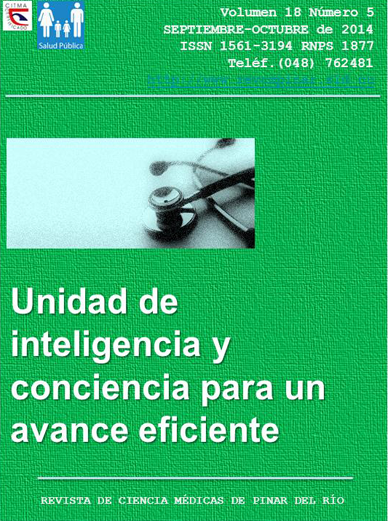Los medios de enseñanza y las tecnologías de la información y las Comunicaciones en la formación de Tecnólogos de la Salud
Palabras clave:
Enseñanza, Educación profesional.Resumen
Introducción: los medios de enseñanza constituyen uno de los componentes del proceso docente educativo que favorece la concepción científica del mundo y la asimilación de los conocimientos.
Objetivo: caracterizar los medios de enseñanza y el uso de las tecnologías de la información y las comunicaciones en el proceso de formación de tecnólogos de la salud en la carrera de Bioanálisis Clínico.
Material y métodos: estudio de corte pedagógico en la carrera de Bioanálisis Clínico de la Filial Tecnológica "Simón Bolivar" de Pinar del Río donde se emplearon métodos del nivel teórico y del nivel empírico como la encuesta a alumnos y la entrevista a profesores. Se hizo coincidir de forma intencionada el universo y la muestra (67 estudiantes y 17 profesores).
Resultados: los medios más utilizados fueron los tradicionales, se considera insuficiente los productos informáticos en la institución, se valora como positivo y necesario el uso de las nuevas tecnologías para la confección de medios de enseñanza.
Conclusiones: los medios más utilizados en el aprendizaje de los contenidos de las asignaturas en la carrera son los medios tradicionales. Se carece de bibliografía básica en las asignatura para la dirección adecuada del proceso enseñanza-aprendizaje y de medios de enseñanza apoyados por la tecnología para satisfacer la asequibilidad en su asimilación y la motivación por el aprendizaje.
Descargas
Citas
1. Gutiérrez-Escobar M, López-Fernández R, Yanes-Seijo R, Llerena-Bermúdez M, Rosa-Rodríguez M, Olano-Rivalta M. Medios de enseñanza con nuevas tecnologías versus preparación de los docentes para utilizarlos. Medisur [revista en Internet]. 2013 [citado 2014 Feb 24]; 11(2): [aprox. 8 p.]. Disponible en: http://medisur.sld.cu/index.php/medisur/article/view/2238
2. V Prieto Díaz V, Quiñones La Rosa I. Impacto de las tecnologías de la información y las comunicaciones en la educación y nuevos paradigmas del enfoque educativo, Educ Med Super. mar. 2011; 25(1):20-30.
3. Montes de Oca Recio N, Machado Ramírez EF. Estrategias docentes y métodos de enseñanza-aprendizaje en la Educación Superior. Rev Hum Med. 2011 Dic; 11(3): 475-488.
4. Peñalver Rodríguez VM, Pérez Peñalver O. La asignatura Aseguramiento de la Calidad y su evaluación en un escenario virtual. Educación Médica Superior. 2012; 26(4).
5. Ruiz-Piedra A, Gómez-Martínez F. Software educativo y principios éticos. Educación Médica Superior [revista en Internet] 2013 [citado 2014 Feb 19]; 27(2):[aprox.0p.]. Disponibleen: http://www.ems.sld.cu/index.php/ems/article/view/161
6. Grau-León I, Cabo-García R, Barciela-González-Longoria M. Diseño y elaboración de la asignatura Rehabilitación soportada en las tecnologías de la informática y las comunicaciones (TICs). Educación Médica Superior [revista en Internet]. 2013 [citado 2014 Feb 20]; 27(2):[aprox. 0 p.]. Disponible en: http://www.ems.sld.cu/index.php/ems/article/view/168
7. Seijo Echevarría BM, Iglesias Morel N, Hernández González M, Hidalgo García CR. Métodos y formas de organización del proceso de enseñanza-aprendizaje. Sus potencialidades educativas. Rev Hum Med. 2010 Agos; 10(2).
8. Rosell-Puig W, González-Hourruitiner A. Criterios de clasificación y selección de los medios de enseñanza. Educación Médica Superior [revista en Internet] 2012 [citado 2014 Feb 20]; 26(2):[aprox. 0 p.]. Disponible en: http://www.ems.sld.cu/index.php/ems/article/view/36
9. Salas-Perea RS. Los medios de enseñanza en la educación en salud. Biblioteca de Medicina Volumen XXIII, Capítulo 11. Universidad Mayor de San Andrés, La Paz, 1998.
10. Falcón-Villaverde M. La educación a distancia y su relación con las nuevas tecnologías de la información y las comunicaciones. Medisur [revista en Internet]. 2013 [citado 2014 Feb 24]; 11(3): [aprox. 15 p.]. Disponible en: http://www.medisur.sld.cu/index.php /medisur/article/view/2418
11. Díaz-Rodríguez L, Hernández-Leyva L, Rodríguez-Rodríguez C, Brito-Liriano L. Multimedia educativa para el perfeccionamiento del proceso enseñanza-aprendizaje de la asignatura Biología Celular. EDUMECENTRO [revista en Internet]. 2013 [citado 2014 Feb 24]; 4(1):[aprox. 11 p.]. Disponible en: http://www.revedumecentro.sld.cu/index.php/edumc/article/view/157
12. Herrera-Salasar M, Herrera-Salasar R, Pérez-Martín F. Sitio Web para el proceso enseñanza aprendizaje en Bioquímica de Tecnología de la Salud. EDUMECENTRO [revista en Internet]. 2013 [citado 2014 Feb 27]; 4(2): [aprox. 11 p.] Disponible en: http://www.revedumecentro.sld.cu/index.php/edumc/article/view/179
Publicado
Cómo citar
Número
Sección
Licencia
Aquellos autores/as que tengan publicaciones con esta revista, aceptan los términos siguientes:- Los autores/as conservarán sus derechos de autor y garantizarán a la revista el derecho de primera publicación de su obra, el cuál estará simultáneamente sujeto a la Licencia de reconocimiento de Creative Commons que permite a terceros compartir la obra siempre que se indique su autor y su primera publicación esta revista.
- Los autores/as podrán adoptar otros acuerdos de licencia no exclusiva de distribución de la versión de la obra publicada (p. ej.: depositarla en un archivo telemático institucional o publicarla en un volumen monográfico) siempre que se indique la publicación inicial en esta revista.
- Se permite y recomienda a los autores/as difundir su obra a través de Internet (p. ej.: en archivos telemáticos institucionales o en su página web) antes y durante el proceso de envío, lo cual puede producir intercambios interesantes y aumentar las citas de la obra publicada. (Véase El efecto del acceso abierto).



